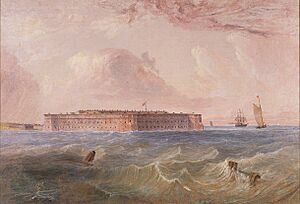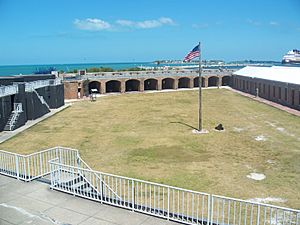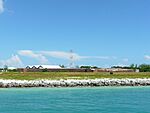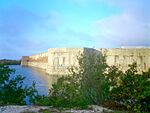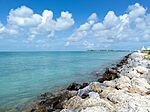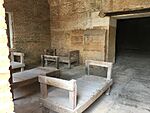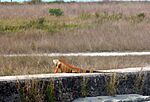Fort Zachary Taylor Historic State Park facts for kids
|
Fort Zachary Taylor
|
|
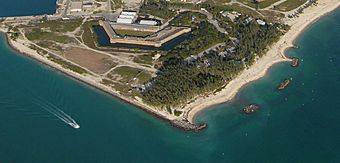
Aerial view of Fort Zachary Taylor State Park
|
|
| Location | Monroe County, Florida, USA |
|---|---|
| Nearest city | Key West, Florida |
| NRHP reference No. | 71000244 |
Quick facts for kids Significant dates |
|
| Added to NRHP | March 11, 1971 |
| Designated NHL | May 31, 1973 |
Fort Zachary Taylor Historic State Park, often called Fort Taylor, is a special park in Key West, Florida. It's built around an old fort from the American Civil War. This fort is also a National Historic Landmark, meaning it's a very important historical place in the United States.
Contents
History of Fort Taylor
Building the Fort (1845–1900)
Building Fort Taylor started in 1845. It was part of a big plan to protect the southeast coast of the United States. After the War of 1812, the country wanted a strong line of forts. Key West was chosen as a good spot for one of these forts.
The fort was named after U.S. President Zachary Taylor in 1850. This happened just a few months after he passed away. Two smaller forts, called Martello Towers, were also built nearby. They helped protect the main fort.
Who Built the Fort?
The United States Army Corps of Engineers oversaw the construction. They hired workers, including enslaved people, from the local area. Before the fort, Key West didn't have many enslaved people. But for this big project, many more were brought in to help build.
How the Fort Was Built
The fort's base was made of oolitic limestone and New England granite. Its walls were about 5 feet thick and stood 50 feet above the water. The fort had two levels of rooms for guns, called casemates. On top was a flat area for more cannons.
Three long walls faced the sea, each with 42 guns. The side facing land had barracks for up to 800 soldiers. There were also large rooms for gunpowder. A long path, about 1,200 feet long, connected the fort to the land. Rainwater was collected in tanks underground. Building the fort took a long time because of diseases and a lack of supplies.
Fort Taylor During the Civil War
Even before the American Civil War began in 1861, the U.S. government knew Fort Taylor was important. On January 13, 1861, Union Captain John Milton Brannan moved his soldiers into the fort. He did this to make sure it didn't fall into Confederate hands.
The fort became a key spot for the Union. It helped stop ships that were trying to sneak past the Union blockade. These ships were called blockade runners.
Changes to the Fort
In 1898, the fort was made shorter, down to two stories. New gun batteries were added. Battery Osceola had two large 12-inch guns. Battery Adair had four smaller, faster-firing guns. Old Civil War cannons were even buried inside the new batteries to help fill them up.
The fort was also used during the Spanish–American War (1898), World War I, World War II, and the Cuban Missile Crisis in 1962.
Fort Taylor Today (1947–Present)
After World War II, the U.S. Army didn't need the fort anymore. In 1947, it was given to the United States Navy. In 1968, a group of volunteers, led by Howard S. England, started digging. They found many Civil War guns and ammunition that had been buried. This discovery created the largest collection of Civil War cannons in the country.
Fort Taylor was recognized as a special historical place in 1971. It became a National Historic Landmark in 1973. Over time, more land was added around the fort, including a nice beach. Now, the park covers about 87 acres.
The Truman Annex
The land near the fort became part of the Truman Annex. This area was once a large naval base. President Harry S. Truman used this naval base as his "Winter White House." He visited Key West many times. A private beach was even built for him, but he only visited it once.
The naval base closed in 1974. Most of the land was sold to private companies. A museum was built for the Truman White House. The Navy still owns some parts of the area, including the piers, which are used to support certain operations.
What You Can Do at Fort Taylor Today
Today, Fort Taylor and its beach are popular places for tourists to visit. You can explore the old fort and learn about its history. The park also hosts special events every year. These include week-long Civil War reenactments, where people dress up and act out historical battles.
Images for kids
-
The fort as seen from the Gulf of Mexico




